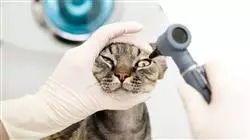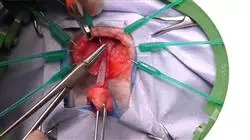University certificate
The world's largest faculty of veterinary medicine”
Introduction to the Program
This program is the best investment you can make to update your knowledge in Feline Medicine and Surgery”

Feline Medicine has experienced a great boom in the last decade, being one of the most demanded areas by clinical veterinarians for several reasons. The first of these is the lack of specific studies within the veterinary career, which means that many of the courses or postgraduate courses are focused on covering this lack of basic knowledge.
The second point, and perhaps the most important, is that veterinarians, who see how the number of feline patients is increasing every day, as well as their owners, demand greater specialization. And the third point is that there are already many colleagues who want to dedicate themselves exclusively to this species, so they are also looking for a study program according to their needs and expectations.
Although many professionals do not consider Feline Medicine as a specialty, the nature of the cat makes it essential to have a deep knowledge of this species in order to prevent any problem, to approach all pathologies in an adequate way and to solve the most complex cases, which makes specialization essential.
The Professional master’s degree in Feline Medicine and Surgery is focused on specialization, as well as on updating, directing our gaze to the future of medicine in the feline species. Specialization through a fully integrated vision of the cat as a species, first addressing its requirements and then focusing on the most relevant areas by the hand of recognized experts in each of them both in medicine and in diagnostic imaging and surgery. Updating as a response to the need for specialization and exclusive and different attention to their patients.
As strengths of this Professional master’s degree, each module develops the use of minimally invasive techniques, interventional cardiology, new monitoring and therapeutic alternatives for various pathologies of the feline species.
As it is an online program, students will not be bound by fixed schedules or the need to move to another physical location, but rather, they can access the content at any time of the day, balancing their professional or personal life with their academic life.
The Professional master’s degree in Feline Medicine and Surgery pursues excellence in both theory and daily practice in order to offer quality care to your feline patients.
Incorporate the latest advances in Feline Medicine into your daily practice. It's the perfect opportunity to advance your career"
This Professional master’s degree in Feline Medicine and Surgery contains the most complete and up-to-date educational program on the market. Its most notable features are:
- The development of case studies presented by experts in Feline Medicine and Surgery
- The graphic, schematic, and practical contents with which they are created, provide scientific and practical information on the disciplines that are essential for professional practice
- Practical exercises where self-assessment can be used to improve learning
- Its special emphasis on innovative methodologies
- Theoretical lessons, questions for experts and individual reflection work
- Content that is accessible from any fixed or portable device with an Internet connection
You will learn how to develop a protocol to identify and localize the main alterations affecting the nervous system in the feline species"
The program’s teaching staff includes professionals from the sector who contribute their work experience to this training program, as well as renowned specialists from leading societies and prestigious universities.
The multimedia content, developed with the latest educational technology, will provide the professional with situated and contextual learning, i.e., a simulated environment that will provide immersive education programmed to learn in real situations.
This program is designed around Problem-Based Learning, whereby the professional must try to solve the different professional practice situations that arise during the academic year. For this purpose, the student will be assisted by an innovative interactive video system created by renowned and experienced experts.
A unique program that stands out for the quality of its contents and its excellent teaching staff, composed of professionals with years of experience in the sector"

This specialisation comes with the best didactic material, providing you with a contextual approach that will facilitate your learning"
Why study at TECH?
TECH is the world’s largest online university. With an impressive catalog of more than 14,000 university programs available in 11 languages, it is positioned as a leader in employability, with a 99% job placement rate. In addition, it relies on an enormous faculty of more than 6,000 professors of the highest international renown.

Study at the world's largest online university and guarantee your professional success. The future starts at TECH”
The world’s best online university according to FORBES
The prestigious Forbes magazine, specialized in business and finance, has highlighted TECH as “the world's best online university” This is what they have recently stated in an article in their digital edition in which they echo the success story of this institution, “thanks to the academic offer it provides, the selection of its teaching staff, and an innovative learning method aimed at educating the professionals of the future”
A revolutionary study method, a cutting-edge faculty and a practical focus: the key to TECH's success.
The most complete study plans on the university scene
TECH offers the most complete study plans on the university scene, with syllabuses that cover fundamental concepts and, at the same time, the main scientific advances in their specific scientific areas. In addition, these programs are continuously being updated to guarantee students the academic vanguard and the most in-demand professional skills. In this way, the university's qualifications provide its graduates with a significant advantage to propel their careers to success.
TECH offers the most comprehensive and intensive study plans on the current university scene.
A world-class teaching staff
TECH's teaching staff is made up of more than 6,000 professors with the highest international recognition. Professors, researchers and top executives of multinational companies, including Isaiah Covington, performance coach of the Boston Celtics; Magda Romanska, principal investigator at Harvard MetaLAB; Ignacio Wistumba, chairman of the department of translational molecular pathology at MD Anderson Cancer Center; and D.W. Pine, creative director of TIME magazine, among others.
Internationally renowned experts, specialized in different branches of Health, Technology, Communication and Business, form part of the TECH faculty.
A unique learning method
TECH is the first university to use Relearning in all its programs. It is the best online learning methodology, accredited with international teaching quality certifications, provided by prestigious educational agencies. In addition, this disruptive educational model is complemented with the “Case Method”, thereby setting up a unique online teaching strategy. Innovative teaching resources are also implemented, including detailed videos, infographics and interactive summaries.
TECH combines Relearning and the Case Method in all its university programs to guarantee excellent theoretical and practical learning, studying whenever and wherever you want.
The world's largest online university
TECH is the world’s largest online university. We are the largest educational institution, with the best and widest online educational catalog, one hundred percent online and covering the vast majority of areas of knowledge. We offer a large selection of our own degrees and accredited online undergraduate and postgraduate degrees. In total, more than 14,000 university degrees, in eleven different languages, make us the largest educational largest in the world.
TECH has the world's most extensive catalog of academic and official programs, available in more than 11 languages.
Google Premier Partner
The American technology giant has awarded TECH the Google Google Premier Partner badge. This award, which is only available to 3% of the world's companies, highlights the efficient, flexible and tailored experience that this university provides to students. The recognition as a Google Premier Partner not only accredits the maximum rigor, performance and investment in TECH's digital infrastructures, but also places this university as one of the world's leading technology companies.
Google has positioned TECH in the top 3% of the world's most important technology companies by awarding it its Google Premier Partner badge.
The official online university of the NBA
TECH is the official online university of the NBA. Thanks to our agreement with the biggest league in basketball, we offer our students exclusive university programs, as well as a wide variety of educational resources focused on the business of the league and other areas of the sports industry. Each program is made up of a uniquely designed syllabus and features exceptional guest hosts: professionals with a distinguished sports background who will offer their expertise on the most relevant topics.
TECH has been selected by the NBA, the world's top basketball league, as its official online university.
The top-rated university by its students
Students have positioned TECH as the world's top-rated university on the main review websites, with a highest rating of 4.9 out of 5, obtained from more than 1,000 reviews. These results consolidate TECH as the benchmark university institution at an international level, reflecting the excellence and positive impact of its educational model.” reflecting the excellence and positive impact of its educational model.”
TECH is the world’s top-rated university by its students.
Leaders in employability
TECH has managed to become the leading university in employability. 99% of its students obtain jobs in the academic field they have studied, within one year of completing any of the university's programs. A similar number achieve immediate career enhancement. All this thanks to a study methodology that bases its effectiveness on the acquisition of practical skills, which are absolutely necessary for professional development.
99% of TECH graduates find a job within a year of completing their studies.
Professional Master's Degree in Feline Medicine and Surgery
The demand for Feline Medicine has increased significantly in recent years and many clinical veterinarians are seeking courses or postgraduate degrees to cover the lack of specific preparation in this area. In addition, the number of feline patients has increased and many owners demand greater specialization for this species. This is why this Professionale Master's Degree in Feline Medicine and Surgery takes on special importance, providing the veterinary professional with a fully integrated vision of felines, addressing their most relevant areas.
Effectively manage all the pain symptoms of the feline patient
The Professionale Master's Degree in Feline Medicine and Surgery highlights the use of minimally invasive techniques, interventional cardiology and new therapeutic alternatives. Being a 100% online program, students can access the contents at any time, allowing them to balance their work or personal life with their academic life. Thus, with only a device with an Internet connection they will be able to boost their professional career by testing their skills through demanding simulations of real cases. Similarly, they will consult throughout the 1,500 hours of the degree course useful videos and interactive schemes.







